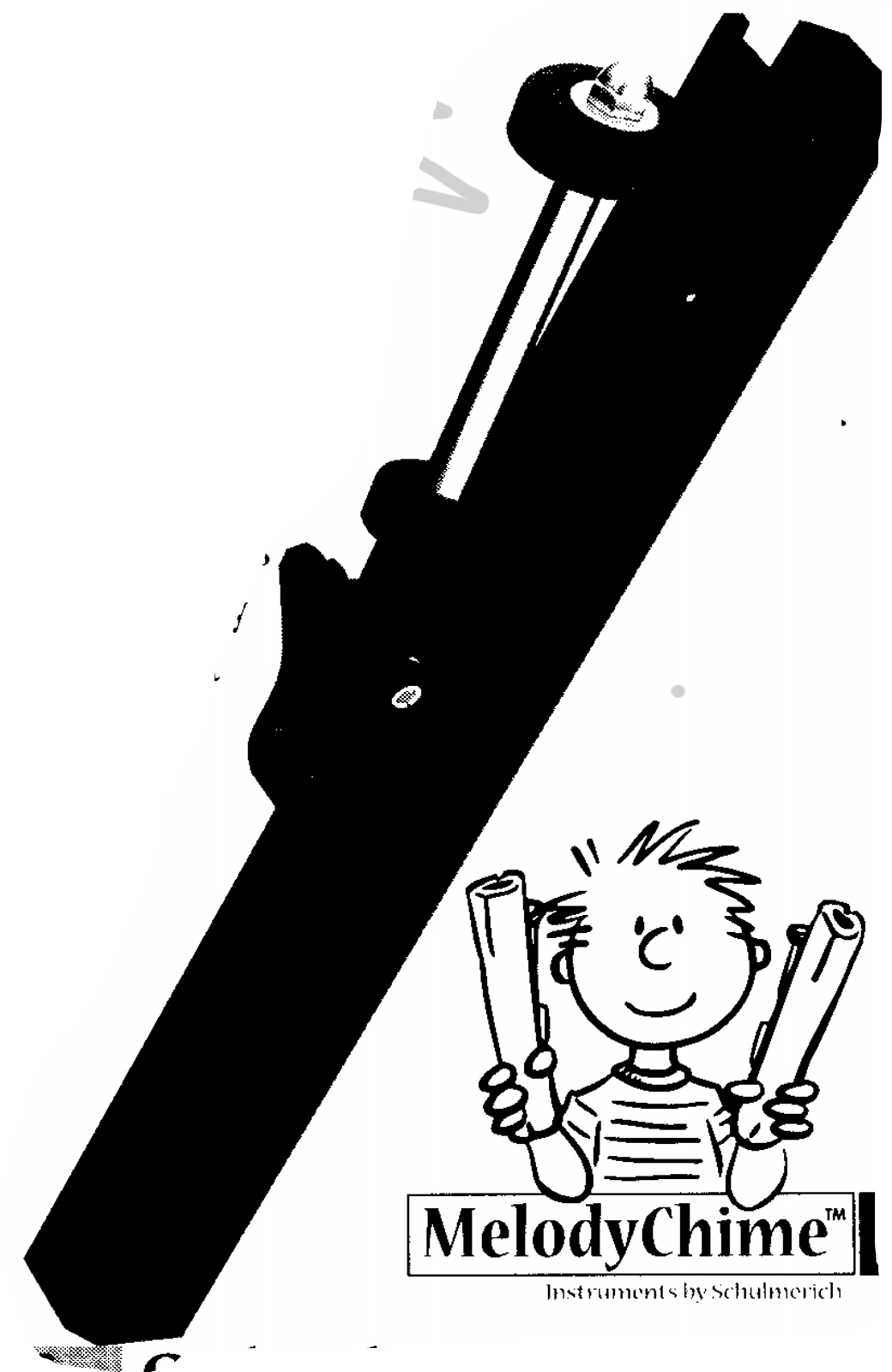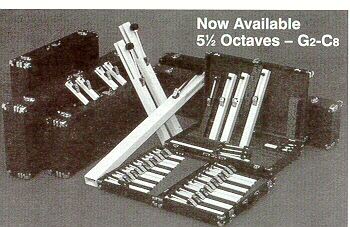
Frequently Asked Questions
Handchimes



Schulmerich
Malmark
Suzuki

Frequently Asked Questions
Handchimes



Schulmerich
Malmark
Suzuki
My favorite quote from Paul Rosene: "Remember, Chimes are to be played gently! They sound best with a gentle approach....avoid "pounding" or "hitting them with force," which will only "stifle" the beautiful timbre."AGEHR, Inc. states: The handchime is a metal tube, most commonly an aluminum extrusion, slotted and cut to produce a musical tone. The length of the slot in the tubing determines the fundamental pitch which is the clearly dominant tonal element, while the length of the unslotted portion (that which is held in the hand) is slected and fitted with a plug to provide substantial reinforcement of the tonal frequency produced by the slotted portion (the tines). The clapper mechanism is externally mounted and strikes the tube at the predetermined point to produce the desired pitch.
When rapidly moved forward, the hammer strikes the tube which resonates a tuned frequency. Each Handchime is of different length, therefore, different pitch. A set of 13, 25, 37 or more handchimes, chromatically tuned, comprise as set.
Many styles of music may be produced with handchimes. The sustained, lush tone lends itself to slower tempos.
A CHIME WORKSHOP -- Thanks to Dr. Paul E. Rosene for the following on-the-spot Workshop for Handchimes. He has led the field in the use of Handchimes in Education for many years. We are endebted for his willingness to share of his expertise and information. Contact information is listed at the end of the section.
THE HANDCHIME -- Quotes
"Handchimes are easy to play!
"Self-esteem is easily and quickly attained."
"Playing chimes incorporates many skills."
"It is fun to play them."
"Handchimes can enhance worship."
"Handchimes provide a "new timbre:" a pleasant variety of sound for the audience."
Their sound is truly HEAVENLY."WHAT ARE THEY? -- Handchimes are basically aluminum tuning forks with a Handbell-like mallet permanently attached. Chimes, therefore, are always ready to be played.
Each chime is labeled with its pitch, octave number and staff location.
Handchimes are color-coded for easy identification.
CHIMES LAYOUT -- Handchimes can be played in a variety of ways. Some music educators have each child play one pitch. However, Handchimes are usually chromatically arranged on a table, from "chimers" left to right, and so that the assigned LEFT chime is lower in pitch than the RIGHT one. When organized on a table, chimes should be placed on a soft surface, foam pads, thick carpeting, blankets, etc., to avoid damage to the instruments.
The preferred assignment is to give TWO diatonically named chimes plus their same name sharp/flat chimes to the same player. (For instance: C and D plus C# and D# (Eb.) Chimes with the same name should be played by the same Chimer: (F and F# played by the same individual.)
HOW TO "CHIME" (PLAY!) The beauty of chimes is best produced if played with a gentle and easy stroke. They are not intended to be presented in a loud manner. Chiming with too much energy (or with an overzealous, boisterous effort) destroys the inherent beautiful tone quality and could result in damage to the tines or chimetube. Just play them gently!
1. The chime tube is held vertically, tines up, with the clapper mechanism facing the shoulder.
2. The hand is positioned below the designation label and as low on the chimetube as is comfortable and practical for the individual chimer.
3. The thumb and forefingers should be in a complete circle, completely surrounding the chimetube.
4. The remaining fingers grip the chimetube in a natural position. The grip is similar to holding a tennis racquet or baseball bat.
5. Begin the chiming stoke with the chime slightly tilted back and toward the shoulder. To begin, move the arm holding the chime down and then away in a circular motion, bringing it up at the extreme end for the movement, but keeping the chimetube vertical! The produce the sound, moving the arm forward in the circular motion, but then snap the wrist at the arm extension.
6. After snapping the wrist to produce the sound of the chime, lift the chimetube slightly and continuing in the circular motion, bring the chime back to the shoulder.
7. Near the shoulder, the "damp" (cessation of sound) is then achieved by touching the vibrating tines to the shoulder or padded table.
8. After the damp is produced, move the chimetube slightly away from the shoulder, ready to chime again.
9. In rapid passages, keep the chime close the body and chime it very close to the shoulder. This will allow a "quick damp" process.
HOW TO DAMP -- As with Handbells, the Handchime needs to be correctly and accurately damped. Touching the vibrating tines to the shoulder or table. (See method books for complete instructions.)MAINTENANCE -- Maintenance of Handchimes is minimal. Handle them as quality musical instruments and many years of satisfactory performance will be ensured. Do not attempt to change the clapper head settings. They are established at the factory for maximum quality of sound for the particular chimetube. Wipe the chimetubes with "handi-wipes" or similar product after each use will keep then sanitary and clean.
LITERATURE -- Drills and special arrangements can be very helpful as warm-ups.
A piece should be appropriate for the group…not only the selection itself, but also its level of difficulty.
Any Handbell arrangement can be played with chimes. There is no such thing as "exclusive Handchime or
exclusive Handbell music! All bell/chime musics are completely interchangeable.Hymnals and/or basic music series books can be easily used. With a bit of rearranging, piano music an also be adjusted for Handchime use.
Many Handbell compositions and arrangements with solo and/or duet instruments can be substituted as a chimes solo/due instead.
Chimes can double with Handbells to create a whole new timbre.
When playing pieces with repeated choruses, alternate Handbells with Handchimes for chorus to chorus to provide variety of sound.
SOME USEFUL COLLECTIONS
1. BEGIN TO RING II 2 Octaves Thompson/Callahan HOPE #1242USES -- There are a great many uses for the hand-held chiming instruments. Chuches, schools, all kinds of fraternal organizations, and in Senior Citizens centers! An organization of Chimers brings about many joys: making music together, socialization, entertainment, worship enhancement, music reading procedures and the positive development of "I can do it" feelings!
2. BEGIN TO RING III 3 Octaves Thompson/Callahan HOPE #1243
3. CLAPPER CLASSICS II 2 Octaves Thompson/Callahan HOPE # 1253
4. CLAPPER CLASSICS III 3 Octaves Thompson/Callahan HOPE #1254
5. KEY RINGS 3 Octaves with Keyboard Thompson/Callahan HOPE #1348
6. FOLK SONGS FOR BELLS 2 Octaves Alman, Doris HOPE #1391
7. INTRODUCTION TO HANDCHIMES Buntin, L. Campbell FLAMMER #HL5170
8. LET’S RING CHIMES 2 Octaves Mitchell, Kirsty 12454 Pine Rock, Houston, TX 77024
9. LET THE CHILDREN RING 2 Octaves Armstrong, Gerald BROADMAN #4591-04
10. LET THE CHILDREN RING…MORE! Armstrong, Gerald BROADMAN #4591-22
11. LET THE SENIORS RING! 2 Octaves Armstrong, Gerald BROADMAN #4591-20
12. MAKING MUSIC WITH CHOIRCHIME* INSTRUMENTS 2 Oct. Rosene, Paul HOPE #1159
13. MAKING MUSIC WITH CHOIRCHIME* INSTRUMENTS – ADVANCED METHOD
3 Octaves Rosene, Paul HOPE #1252
14. LEARNING TO RING (series) -- Berry/VanValey LORENZ #HB200
15. READY TO RING 2-5 Octaves Thompson/Callahan HOPE #1110
16. READ TO RING III 3 Octaves Thompson/Callahan HOPE #1198
17. READY TO RING FOR CHRISTMAS Thompson/Callahan HOPE #1352
18. RINGING BASICS 2 Octaves Simpson, Beverly FLAMMER #HL-5231
19. RINGING BASICS 3 Octaves Simpson, Beverly FLAMMER #HL-5270
20. RINGING FOR THE FIRST TIME McKechnie, Linda FLAMMER #HL-5232
Director’s Book: FLAMMER # HL-5233
21. SPECIAL EFFECTS FOR HANDCHIMES Rosene, Paul. AGEHR, Inc., Dayton, Ohio. R-227 (2003)DISCOVER HANDCHIMES!
1. Melody line played by chimes, harmony provided by Handbells.
2. Melody played with Handbells, harmony from chimes.
3. Handchime solo.
4. Handchime solo with keyboard accompaniment.
5. Chimes play with the vocal Choir, with chimes providing a descant.
6. Intersperse chimes with a Handbell Ensemble. Selected portions of many Handbell arrangements can be played with a three octave set of chimes.
7. Entire composition played with chimes alone.
8. "Echo" effects developed with Handchimes. Play repeated selections within Handbell music with chimes to provide the "echo."
9. Chimes used as an accompaniment for a vocal or instrumental solo.
10. Two Handbell choir selections can be played with great contrast by use of chimes playing the "second" Handbell part.
11. Many contemporary Handbell arrangements include chime notes as an integral portion of the selection.
Dr. Paul E. Rosene, Music Educator
Handbell/Choirchimes* Consultant
Music Education - School Bands/Orchestras
822 Pinar Drive
Orlando, FL 32825-7822
e-mail: rosenebell@aol.com
Phone: 407/803-7861Back to Top
How do I select a Handchimes to purchase?
There are three manufacturers of handchimes, Malmark, Shulmerich, and Suzuki. Suzuki is in Japan. Each of these companies are reputable and stand behind their products. Each has representatives in the United States and multiple maintenance sites.
The best way to select a handchime is to request a demonstration. It would be to your advantage to arrange a comparison demo, that is, have representatives present at the same time with a set a handchimes. Seeing, hearing, playing, and having an explanation of the benefits of each product will avoid the "lapse of memory" we often have when a new timbre replaces the old.
If this is not possible, visit several bell groups with different handchimes to make your comparisons. This can be easily done by attending a workshop or festival. Directors and ringers are most anxious to demonstrate and explain why they like their bells. They are also willing to tell of any problems or deficiencies they have had.
Handbell/Handchime Loan Programs
The following Areas of AGEHR Inc. offer loaner sets of handbells or handchimes to members in their Areas. Click on the area website and contact the chair to learn more about the programs, which vary from Area to Area.
Area I -- CT, ME, MA, NH, RI, VT, NB, NS, PEI, Quebec -- 3 - sets handchimes
Area II -- NJ, NY, PA, Ont -- 9 sets of 3 octave handchimes
Area III -- DE, DC, MD, NC, VA
Area IV -- FL, GA, SC, Puerto Rico, Bahamas, Virgin Islands
Area V -- IN, KT, MI, OH, WV -- 9 - sets handchimes for schools -- 2 - sets for special needs groups.
Area VI -- AL, AR, LA, MS, TN -- loans handchimes
Area VII -- MN, ND, SD, WI, Man -- 3 octave handbell set; three octave chime set
Area VIII -- Illinois, Iowa, Kansas, Missouri, Nebraska
Area IX -- OK, TX
Area X -- AK, ID, MT, OR, WA, Alberta, Bristish Columbia, Saskatchewan
Area XI -- AZ, CO, NM, UT, WY
Area XII -- California, Hawaii, Nevada, Guam -- 1 - three octaves bells 1 - three octaves chimes
Where Do I Find Instructions on Playing Handchimes?
AGEHR has several Resource Books that would be beneficial in learning about the use of Handchimes, for regular groups or "Special Groups" of impaired ringers. Click on http://www.agehr.org, go to the Guild Store, and click on "Resources."
Dr. Paul Rosene was one of the forerunners in promoting handchimes, particularly in Education. He has written text books and arranged music for handchimes. Contact him at Rosenebell@aol.com. Some of his books may be available at your favorite handbell supplier.
"Manufacture of Chime Instruments"Chime instruments use a combination of tin and aluminum alloys and are extruded aluminum tubes which are made in various diameters and lengths and then have an external clapper mechanism attached to the body of the
instrument. The ratio of the combination of the alloys, the size, length and diameter of the tube, along with the internal stop block determines the pitch of the instrument.
If you have questions you feel should be included in this FAQ, contact . It will be helpful if you will state the question similar to those above, and if possible, give a short, definitive statement to answer the question. The editor will review your question and answer, consider whether to include the question, and amend as deemed necessary.